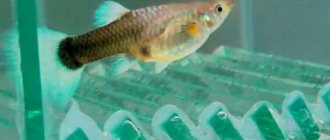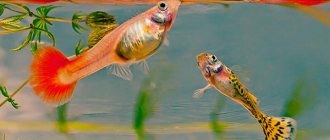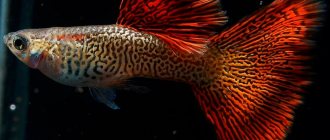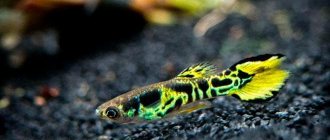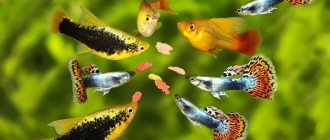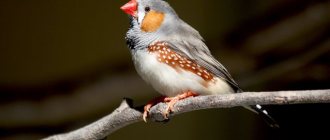As soon as the eggs hatch, you are just beginning your journey in fish breeding and raising fry.
After all, raising a fry is often a more difficult task than getting a couple to spawn, and getting eggs is only half the battle. On the one hand, most cichlids and viviparous fish give birth to fry large enough to immediately begin feeding on artificial food, but the majority of aquarium fish, such as pearl gouramis, laliuses, cardinals, and marcropods, give birth to very small fry that need to be fed with the same small food.
Their fry are so small that they themselves could serve as food for a guppy or cichlid fry.
Also, juveniles can only eat food that moves and you will have very little time to train them to eat other foods before they begin to die of hunger.
Next, we will look at the many different foods that aquarists use to feed their fry. Each of them is quite nutritious on its own, but it is better to use several different ones to create a complete diet.
Ready-made feed
Boiled egg yolk
This is a simple and inexpensive food for feeding fry. Among its advantages, it does not create an unpleasant odor, which is a common problem with live food, and is very affordable.
To prepare the food, hard boil a chicken egg, remove the white, all you need is the yolk. Take a few grams of yolk and place it in a container or cup of water. Then shake or mix it thoroughly, as a result you will get a suspension that you can feed to the fry.
If necessary, pass it through cheesecloth to filter out large pieces of yolk. Then you can give the suspension to the fry; as a rule, they stand in the water column for some time and are eaten with appetite.
One yolk can be fed to the fry for a whole month, of course it will not be stored for that long, and do not forget to cook a new one from time to time. Do not add too much mixture to the aquarium at one time, it decomposes quickly and can lead to the death of the fry.
Feed egg yolk sparingly, a few drops a couple of times a day.
Another problem is that the yolk, even after filtering, may be too large for some fry, will not be digested and will begin to disappear at the bottom.
The smallest parts can be obtained using a mixer or blender.
Dry egg yolk
There is no fundamental difference between boiled and dry. Widely used in fry food, but it is very easy to make yourself.
It is enough to boil the egg, dry and crush the yolk. It can be added by pouring it onto the surface of the water or mixing it with water and pouring it into the aquarium.
It floats on the surface of the water, and the yolk mixed with water hangs in the water column for some time. Use both methods to give the fry maximum nutrition.
It is also good to feed small fish with dried egg yolk, as it is much smaller than the smallest flakes. The particle size of dry yolk is smaller than that of diluted in water, which is important if the fry is small.
Liquid artificial feed
This food is already diluted with water. Sometimes the particles are too large for small fry, but manufacturers are constantly improving the quality of such feeds.
New generations of food are already suitable for all types of fry; in addition, their advantage is that they hang in the water for a very long time and the fry have time to eat.
Dry flakes
Widely available, but while they can be fed to large fry such as guppies, they are not suitable for most others.
Often the particle size is equal in size to the fry itself.
How to properly care for young after birth
Caring for guppy fry in a nursery is different from caring for adult fish. The fry need:
- clean water – achieved through filtration and daily replacement of up to 1/2 of the total volume of the container, but no more than 25% at a time;
- lighting – in the first week the lighting is around the clock, with a gradual decrease in daylight hours to standard;
- temperature regime – maintained within 25-28℃;
- food - enhanced nutrition for babies, up to 5 times a day in the first 8-10 days.
We recommend reading
Contents of Platydoras catfish
Live food is welcome - ground rotifers, artemia nauplii, or balanced ready-made mixtures developed by professionals. What to feed guppy fry depends on age. Babies eat whatever they can fit in their mouth. At the age of 4-5 weeks, adolescents are able to feast on chopped bloodworms and tubifex.
Further development depends on the diet of newborn fry. At home, babies are fed yogurt, powdered milk, yolk, and omelet.
Live fish food
Nematode
Excellent food for any fry. They are easy to keep and very small (from 0.04 mm to 2 mm in length and 0.10 mm in width). Unlike a microworm, a nematode culture can be left unfed for several weeks without dying.
The nematode is a soil roundworm - Turbatrix aceti, which can also live in silt. Since nematodes are live food, they are especially suitable if the fry refuses artificial food. Nematodes can live in aquarium water for up to a day, so they do not quickly poison the water and can be eaten by aquarium fish fry within a day.
Nematodes live in very acidic environments, feeding on bacteria. To prepare a growing medium for them, take a mixture of apple cider vinegar and distilled water. Vinegar should be ordinary, without additives.
For example, we take half a liter of vinegar and half a liter of distilled water, mix and add a couple of spoons of sugar or a few slices of an apple without peel.
An apple is needed to create a breeding ground for bacteria. After a week or two, the solution will become significantly cloudier, which means that the bacteria have multiplied rapidly and it’s time to add the nematodes themselves.
Nematode culture can be purchased on the Internet, from birds, or from familiar aquarists.
Add vinegar eels to the solution and place the jar in the dark. In a couple of weeks the culture will be ready.
The most difficult thing is to filter out the nematodes, since they live in a very acidic environment and adding them along with vinegar can be fatal to the fry. You can pour vinegar into a bottle with a narrow neck, seal the top with cotton wool and pour fresh water on it.
Nematodes will move through the cotton wool into fresh water and can be caught with a pipette.
Another method of breeding nematodes is even simpler and more often used.
The nutrient medium is rolled oatmeal or oatmeal, which needs to be brewed until it becomes thick sour cream. After the oatmeal has brewed, you need to add about a teaspoon of table vinegar per 100 grams of medium.
Next, the mass is laid out in a layer of 1-1.5 cm in saucers or other containers and a nematode culture is placed on top. Be sure to cover the container so that there is a moist environment and does not dry out.
In just two or three days, the nematodes will already be crawling onto the walls and can be collected with a brush.
One of the nuances of breeding nematodes in this way is that the culture should be in a warm place. The layer should not be too high, no more than 1.5 cm. If mold appears, then the medium was too liquid or not enough vinegar was added.
Of course, you need to feed the nematodes by adding fresh porridge from time to time. When? This will already be visible in the process. If the yield has decreased, if the medium has darkened or water appears on it, if there is a smell of decomposition.
You can also feed with a few drops of kefir or carrot juice, even a couple of drops of live yogurt.
But it’s easier to have several containers with nematodes in stock and, if something happens, just switch to another one.
Nematodes are excellent food - small, lively and nutritious. They can be fed even to fry of different sizes, since the nematode itself is also different.
Zooplankton - ciliates
Ciliates are not the only microorganisms; they are a mixture of various microorganisms measuring 0.02 mm or more.
To start your own culture of slipper ciliates, place some hay, spinach or dry banana or melon peel in a bottle of water and place it in a sunny place.
The problem is that you cannot control the types of microorganisms in such a culture, and some may be toxic to the fry. To protect yourself, first boil the hay, spinach or banana peel and then add a culture from familiar aquarists to the water, which is dominated by the ciliate slipper.
The water needs to be aerated to reduce the smell from fermentation, and siphoning off the residue from the bottom will extend the life of the crop for a few more days.
So, fill a liter jar with water and bait - dry banana peel, pumpkin peel, hay and place it in a non-sunny place. Add a culture of ciliates to the water, preferably from familiar aquarists.
If not, then you can even get it from a puddle or local reservoir, although there is a risk of bringing something else in. Wait a few days for the ciliates to multiply.
You can catch it in two ways - filtering through paper and lowering it into water or darkening the jar, leaving only one bright place where the ciliates will gather. Then you simply collect them with a tube.
Ciliates are not as tenacious as nematodes, so you will have to start a new jar every couple of weeks. But at the same time they are extremely small and can be eaten by all types of fry.
Green water - phytoplankton
Ciliates can be divided into two categories: zooplankton (we talked about it above) are tiny microorganisms. Phytoplankton are tiny algae, ranging in size from 0.02 to 2 mm in length.
Aquarists use green water as food, but it is actually phytoplankton.
Green water is extremely easy and simple to obtain. Simply take some water from the aquarium, pour it into a jar and place it in the sun.
The sun's rays will cause the water to turn green within a couple of days. When this happens, simply add some water to the aquarium with the fry. Instead, add water from the aquarium.
This is very similar to breeding ciliates, only even simpler. Any water from an aquarium contains both zoo and phytoplankton, but by increasing the amount of light we stimulate the growth of phytoplankton.
One problem is our climate, in winter or autumn there won’t be enough sunlight, but you can just put it under a lamp, the main thing is that the water does not overheat.
Green water is simple, accessible, very small in size, and fry eat it well from the first days of their lives. And most importantly, it does not die in the aquarium and serves as a source of food for the fry for several days. For greater efficiency, you need to keep several jars at the same time, in case the plankton suddenly dies in one.
If you have a microscope, then you can generally grow only the crop that you need, but in my opinion this is unnecessary.
Microworm
The microworm (Panagrellus redivivus) is a small nematode (0.05-2.0 mm long and 0.05 mm wide) that appears too small for a fry. But they have one quality that makes them stand out: they are very nutritious.
To create a microworm culture, mix cornmeal and water until creamy, then add a quarter teaspoon of yeast.
Place in a jar with a lid, which has holes for ventilation, in a layer of no more than 1.5 cm and add a culture of microworms.
The easiest way to get them is from a bird or from familiar aquarists. But if there are none, then you can find a damp pile of fallen leaves in the nearest park, collect them and bring them home. In it you will find very small, white worms, which you need to add to the container with the nutrient mixture.
After a couple of days, you will see microworms crawling out onto the walls and which you can collect with your fingers or a brush.
The fry eat them voraciously, but like nematodes, microworms do not live long in water, and it is important not to overfeed. When you collect them from the walls, some of the nutrient mixture may get into the water, but don't worry, it will also be eaten by the fry.
As a rule, it lasts for two weeks, after which the launch must be repeated. Rolled oats are also used as a nutritional mixture, but the smell from it is more unpleasant and the quality of our oats leaves much to be desired.
However, there are many recipes for preparing the culture; you are free to choose your own.
Guppy nutritional features
Small guppies need to be fed differently than adult guppies. If the big ones are fed twice a day, then the little ones 5 to 6 times. They give enough food at one time so that they can eat it right away. Otherwise, it will settle to the bottom and create life-threatening conditions for the fry in the aquarium: a lot of nitrogen will form , which will lead to the death of the guppy offspring. In addition, water changes should be done daily. It should be taken only from the aquarium where mom and dad swim.
There is no need to say that feeding is an extremely difficult issue, since the fry are ready to eat the food that is also fed to adults. The only question is the size of this food: it should be much smaller, since the mouths of guppy fry are very small. If you feed it dry food, you need to knead it between your fingers so that it turns into dust.
You can choose another option: purchase special food (Tetra MicroMin or Sera Micropan) intended for feeding fry. Both foods are balanced, so you don’t have to add anything: your fry will receive complete nutrition in accordance with their age.
Interesting: Aquarium frogs: features of keeping
There is also a substitute MicroMin , which contains all the vitamins that baby guppies need in the first days of life.
In order for the fry to grow up to full size, they need to be fed carefully. You need to be especially careful about them in the first week. In addition, the light cannot be turned off even for a minute, otherwise the fry may die.
